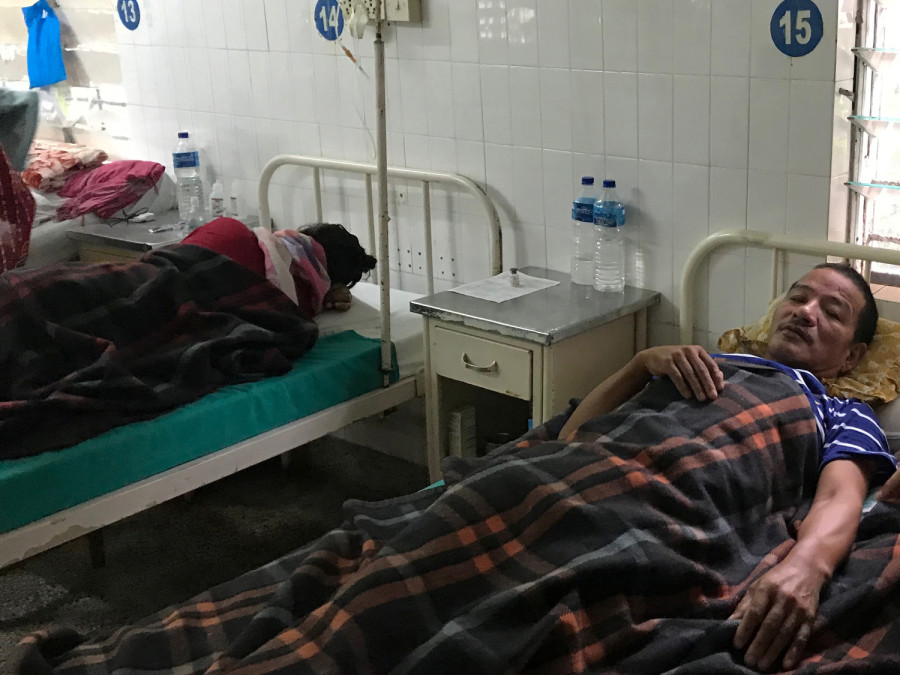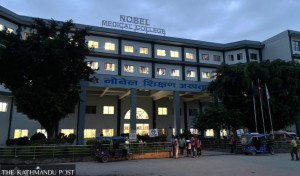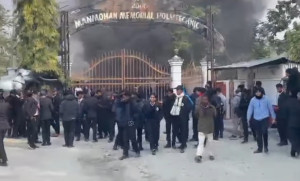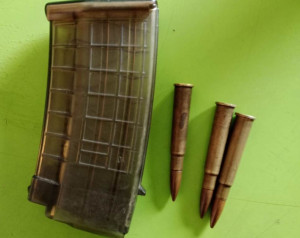Koshi Province
With fresh patients getting diagnosed daily, dengue outbreak in Province 1 is far from being contained
In Dharan alone, 3400 patients have been officially diagnosed with the fever.
Pradeep Menyangbo
Attempts to contain dengue outbreak in Dharan have been of no avail since the dengue virus was first detected in the city on May 12. Instead, the number of infected patients has been increasing across Province 1 districts such as Udayapur, Panchthar and Morang, among others. Local units have implemented a ‘search and destroy’ drive to annihilate the larvae and pupae of the female Aedes aegypti and Aedes albopictus mosquitoes that cause dengue. But the drive has largely been fruitless.
[Related Story: Woman, 35, dies of dengue in Dharan]
Hounding and killing fresh eggs of the mosquitoes is the only viable option to contain the dengue outbreak since there is no medicine or vaccine that could be used to cure the infectious disease, experts say.
In Dharan alone, 3400 patients were officially diagnosed with dengue by Friday, according to Rambabu Yadav, chief of the Department of Health at the Dharan Sub-metropolis.
[Related Story: Province assembly allocates Rs8 million to contain dengue in Dharan]
But this figure is the number of patients diagnosed with the disease in BP Koirala Health and Science Foundation and Bijayapur Hospital only, not including those diagnosed in various private clinics. Experts estimate the total number of dengue-infected people has crossed 5000 in Dharan alone. This is the first time a dengue epidemic of this scale has spread out in such a short time frame.
The months of May and June saw the most number of patients, with the two hospitals diagnosing up to 50 patients in a single day, said Yadav. After June, the number declined slightly, with 25 to 30 patients getting diagnosed daily.
“In one case, seven people from a single family were diagnosed,” said Yadav.
[Related Story: Dharan fight to contain dengue]
Following the outbreak, Dharan was declared a ‘crisis zone’ and a rapid response team was formed, in what was the first time a team as such was formed in the country. The team included specialist doctors and lab technicians from the School of Public Health and Community Medicine Department of the BP Foundation. The team had initiated a door-to-door campaign to intensify the ‘search and destroy’ drive. The Sub-metropolis has already spent more than three million rupees this year to contain the outbreak.
One survey showed a majority of Dharan residents were aware of the disease and its preventive measures, but they did not practically apply the knowledge.
“What we found was the locals knew that they shouldn’t empty their water containers often, should keep the lids closed and surroundings clean,” said Dhiren Limbu, chief of the survey and the microbiology department of Central Technology Campus in Hattisar. “They also knew that they should destroy the larvae and pupae if they spot it. Yet only five percent of the people were found to be applying the knowledge.”
In 2016, the Microbiology Department at the BP Foundation had researched on the two genuses of mosquitoes—female Aedes aegypti and Aedes albopictus—that cause dengue. The investigation focused on four cities—Kakkdabhitta, Damak, Dharan and Biratnagar. The research discovered the serotype-2 virus, one of the four types of viruses that cause dengue.
“The same virus is responsible for the recent outbreak,” said Dr Narayan Bhattarai, additional professor at the department. “This virus is not that harmful. But the chances are that during another outbreak, the patients may contract serotype-3 virus, which is dangerous.”
In the neighbouring district of Udayapur, in the Katari Municipality, 29 people have been infected with dengue, including one doctor.
In Udayapur, too, Katari Municipality has conducted a ‘search and destroy’ drive and other awareness programmes to contain dengue outbreak.
In Panchthar, 33 people have been diagnosed with the disease so far. Last week, the Epidemiology and Disease Control Division said that over a dozen people in Kathmandu have been infected with dengue virus.
Bhattarai said that since the outbreak in Dharan started before the onset of monsoon, the crisis will only get worse in the coming months, likely to continue till October.
“If the larva and pupa are not destroyed by then, the mosquitoes will return during the pre-monsoon season next year,” Bhattarai said.
Dilli Ram Khatiwada in Udayapurand Lila Ballav Ghimire in Panchtharcontributed reporting.
Also, Read:
- Pokhara at high risk of dengue outbreak, a new entomological study shows
- UN health agency warns of possible dengue outbreak in Kathmandu Valley
- Indigenous dengue cases reported in Kathmandu Valley, over a dozen people infected




 7.12°C Kathmandu
7.12°C Kathmandu













%20(1).jpg&w=300&height=200)

